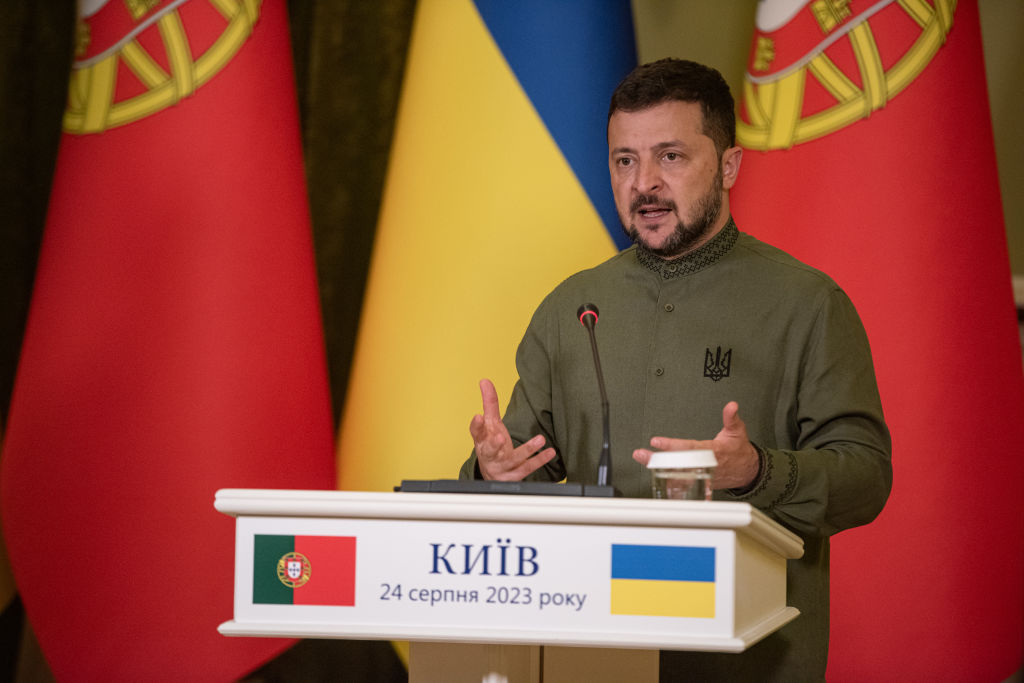
Temperatures soared in Kyiv last weekend. Stuffy apartments were swapped for leafy dachas and crowds flocked to the Dnipro River’s sand beaches. Yet despite the heat, Ukrainians are keeping a careful eye on the calendar—as the end of summer approaches so does an important milestone for the ‘summer counteroffensive’. But while the front lines haven’t moved much in recent months, Ukraine’s diplomatic offensive is gathering pace as it tries to get ahead of pressure to compromise.
In early August, representatives from 42 countries and the United Nations gathered in Saudi Arabia at the urging of Ukrainian President Volodymyr Zelensky. It was the second round of talks meant to rally support for the country’s peace formula, before a global summit planned for autumn. Among its 10 points, it calls for the restoration of Ukraine’s borders recognised in 1991.
To Ukrainians, this is not just a policy. It is a necessity because, they argue, trading victory for peace would be symptomatic of misreading Russia. After enduring centuries of Russian imperialism, Ukrainians have learned that concessions will only be used as staging grounds for future coercion. That’s why ‘Zelensky’s peace plan’, as it’s often called, is also the people’s peace plan. Even under routine air raids and with the promise of another gruelling winter ahead, Ukrainians overwhelmingly oppose giving up territory.
For their part, Ukraine’s Western partners have pledged their wholesale support. In Saudi Arabia, Germany’s representative reportedly commented that Ukraine cannot allow ‘even the thought of a frozen conflict’ or that Russian troops would not be withdrawn. Heavyweights from the global south were also present. Some participants that have so far been unwilling to condemn Russia’s illegal invasion signalled in-principle backing for Ukraine’s territorial integrity.
This is something of a renewed diplomatic offensive. Until recently Ukraine seemed to view peace talks as a distraction from the war effort. As well as Russia’s bad-faith tactics, its monopoly on the peace process was part of the problem. It had convinced the international community that it couldn’t talk about Ukraine’s security without also talking to Russia. Although they were like the earlier discussions in Copenhagen, the Saudi Arabian talks differed because Russia wasn’t invited. This gave Ukraine space to push its own terms for ending the war while increasing Russia’s isolation.
But despite apparently positive results, Kyiv isn’t expecting consensus on all of its peace formula. Some officials from Ukraine’s military donors are convinced that the war will end with talks, not tanks. For non-believers, Ukraine’s counteroffensive is only to improve its negotiating position. Others, disappointed with results from the big push, would prefer Ukraine to open discussions while it still has the initiative. To both parties, the full restoration of Ukraine’s borders will likely be a sticking point.
However, for Ukrainians, a premature peace will remain an unacceptable peace. Even if Ukraine’s government did eventually go to the negotiating table, it likely couldn’t end the war without popular support. As well as being a democracy, Ukraine is relying on an armed force made up of experienced, well-equipped and highly motivated volunteers, with a de facto veto power over any peace deal.
More importantly, though, Ukraine doesn’t need to negotiate. With the right tools, it can win. The question is whether its partners are doing enough to help. Since last February, massive military aid has flowed from west to east. Yet denials and delays meant Ukraine launched its counteroffensive without modern air cover and long-range strike capabilities. True, more help is on the way, but Ukrainians see no sense in negotiating in the meantime.
Another talking point is the promise of NATO membership given to Ukraine in Vilnius last month.
As well as benefiting NATO, this is crucial to Ukraine’s lasting security because of the protection provided by Article 5, which states that an attack on one NATO member is an attack on all. Yet Ukrainians fear it could be used to question the logic of reunification or to pressure Ukraine into a land-for-membership deal.
But this too is a straw man. First, it’s not clear that Article 5 will be extended to Ukraine automatically. And even if it were, NATO is not a cure for all ills. A premature peace would still mortgage Ukraine’s sovereignty and leave millions of its citizens under brutal occupation. It would also reward Russian aggression. Like Russia’s invasion of Georgia 15 years ago and the annexation of Crimea that followed, such ambivalence would surely encourage other land grabs, if not only in Ukraine.
So where does Ukraine go from here? Until Russia withdraws from its territory, a negotiated peace is rightly not part of the plan. Nor is it inevitable. At a special meeting of the heads of Ukraine’s diplomatic missions earlier this month, Zelensky set his ambassadors a task to ‘ensure that the world always stands with Ukraine’. Their work won’t end with summer, just as the ‘summer counteroffensive’ will go on after the leaves turn and the harvest begins. Ukrainians will fight on because this war can’t be ended. This war must be won.

